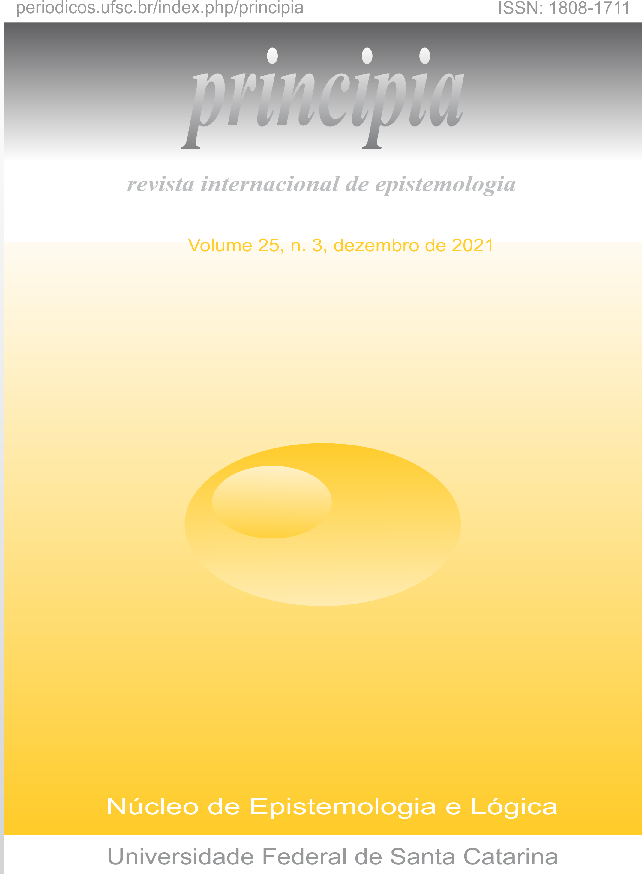David Hume and the gap between the point and the line: the principles of spatial dimension
DOI:
https://doi.org/10.5007/1808-1711.2021.e81397Abstract
The aim of this paper is to present the copy principle from execution of the principle of separability for the purpose of elucidating the discussions conducted by Hume in understanding the composition of space and its implications for the sciences that operate with spatial constructions. The particular epistemic gain here is to do this within a model of empiricism. Given that there are several irregularities in the manner of analyzing a complex and extracting simple elements from it, as will be demonstrated here, we seek to show that separating a complex considering its simple qualities and decomposing a complex to determine its simple quantities is completely different. Thus, we seek to show how Hume needed to recreate his own cognitive model, strongly based on noting our perceptions, to be able to use it to conceive the composition of space and the operations of geometry that must make reference to it.
References
Bayle, Pierre. 1740. Dictionaire historique et critique. [Verbete sobre Zenon d’Elée, 4º v.]. 5eme Édition. Amsterdam, Leyde, La Haye, Utrecht: P. Brunel. 4 vols. in-folio. [Essa edição é uma cópia daquela de 1730; a paginação é a mesma].
Baxter, Donald L. M. 2008. Hume’s Theory of Space and Time in Its Skeptical Context. In: David Fate Norton; Jacqueline Taylor (ed.). Cambridge Companion to Hume, p. 105-46. 2nd Edition. Cambridge: Cambridge University Press.
Beck, Lewis White. 1978. A Prussian Hume and a Scottish Kant. In: Essays on Kant and Hume, p.111-29. New Haven and London: Yale University Press.
Cachel, Andrea. 2017. A ideia de espaço no Tratado da Natureza Humana, de Hume. Philósophos, 22(1): 11-36.
Chambers, Ephraim. 1741. Cyclopaedia: or, an Universal Dictionary of Arts and Sciences. London: for James Knapton, John Darby [etc.]. Cyclopædia, or, An universal dictionary of arts and sciences (2 Volumes) - Full view - UWDC - UW-Madison Libraries (wisc.edu) Acesso: 18/01/2021.
Cummins, Phillip.1990. Bayle, Leibniz, Hume and Reid on Extension, Composites and Simples. History of Philosophy Quarterly, 7(3): 299-314.
Euclides. 2009. Os Elementos. Tradução e Introdução de Irineu Bicudo. São Paulo: Editora Unesp.
Flage, Daniel E. 1981. Hume’s Relative Ideas. Hume Studies, 7(1): 55-73.
Frasca-Spada, Marina. 1997. Reality and coloured points in Hume’s Treatise. Part 1: Coloured points. British Journal for the History of Philosophy, 5(2): 297-319.
Frasca-Spada, Marina. 1998a. Space and the self in Hume’s Treatise. Cambridge: Cambridge University Press.
Frasca-Spada, Marina. 1998b. Reality and coloured points in Hume’s Treatise. Part 2: Reality. British Journal for the History of Philosophy, 6(1): 25-46.
Garrett, Don. 2008. Hume’s theory of ideas. In: Elizabeth S. Radcliffe (ed.). A Companion to Hume, p.41-57. Malden: Blackwell Scientific Publishing.
Hume, David. 2001. Tratado da natureza humana: uma tentativa de introduzir o método experimental de raciocínio nos assuntos morais. Tradução de Débora Danowski. 2 ed. rev. e ampliada. São Paulo: Editora da Unesp; Imprensa Oficial do Estado.
Hume, David. 2007. A Treatise of Human Nature: a critical edition. Editado por David Fate Norton, Mary J. Norton. Vol. 1: Texts. Oxford: Clarendon.
Hume, David. 1999. Uma investigação sobre o entendimento humano. Tradução de José Oscar de Almeida Marques. São Paulo: Editora da Unesp.
Hume, David. 2007. An enquiry concerning human understanding. Edição, introdução e notas por Peter Millican. New York: Oxford University Press.
Kant, Immanuel. 1983. Prolegomena zu einer jeden künftigen Metaphysik die als Wissenschaft wird auftreten können. In: KANT, Immanuel. Werke in zehn Bänden. 5. Aufl. Hrsg. von Wilhelm Weischedel. Darmstadt: Wissenschaftliche Buchgesellschaft. Bd. 5.
Kemp Smith, N. 1941. The philosophy of David Hume. A critical study of its origins and central doctrines. London: Macmillan.
Klaudat, André. 1997. A natureza do projeto filosófico em Hume. Manuscrito, 20(2): 95-121.
Locke, John. 2014. Ensaio sobre o entendimento humano. Introdução, notas e coordenação da tradução de Eduardo Abranches de Soveral. Lisboa: Fundação Calouste Gulbenkian.
Newman, Rosemary. 1981. Hume on Space and Geometry. Hume Studies, 7(1): 1-31.
Norton, David Fate & Norton, Mary. 2007. David Hume. A Treatise of Human Nature: a critical edition. Vol. 2: Material editorial. Oxford: Clarendon.
Pappas, George S. 1989. Abstract General Ideas in Hume. Hume Studies, 15(2): 339-52.
Waxman, Weyne. 2008. Hume and the origin of our ideas of space and time. In: Elizabeth S. Radcliffe (ed.). A Companion to Hume, p.72-88. Malden: Blackwell Scientific Publishing.
Downloads
Published
Issue
Section
License
Copyright (c) 2021 Marcos César Seneda

This work is licensed under a Creative Commons Attribution-NonCommercial-NoDerivatives 4.0 International License.

Principia http://www.periodicos.ufsc.br/index.php/principia/index is licenced under a Creative Commons - Atribuição-Uso Não-Comercial-Não a obras derivadas 3.0 Unported.
Base available in www.periodicos.ufsc.br.



